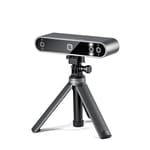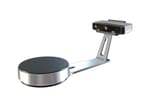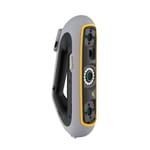A 3D scanner is a truly amazing device that captures a physical object and converts it into a digital copy. Today, there are many types of 3D scanners out there, some of which are better suited to use with a 3D printer.
When choosing a 3D scanner, it’s important to know that there are four main types of 3D scanning:
- Laser triangulation: A laser beam is projected onto the object, measuring the deformation of the ray to develop the digital copy.
- Structured light: A light beam is shined onto the object, measuring the deformation of the light pattern on the surface of the shape.
- Photogrammetry: 2D captures are reconstructed in 3D using computational geometry.
- Contact based: A probe measures the deformation from several sampling points on a surface.
The ideal 3D scanner for a 3D printer uses either laser triangulation or structured light. These methods produce a digital STL file. This format is important for sending a 3D scan directly to a 3D printer.
There are quite a few 3D scanners for 3D printers. To simplify the search and cater to everyone, this article will introduce you to three popular 3D scanners, one each for beginner, intermediate, and professional use. Let’s dive in!
Beginner – Pop 3
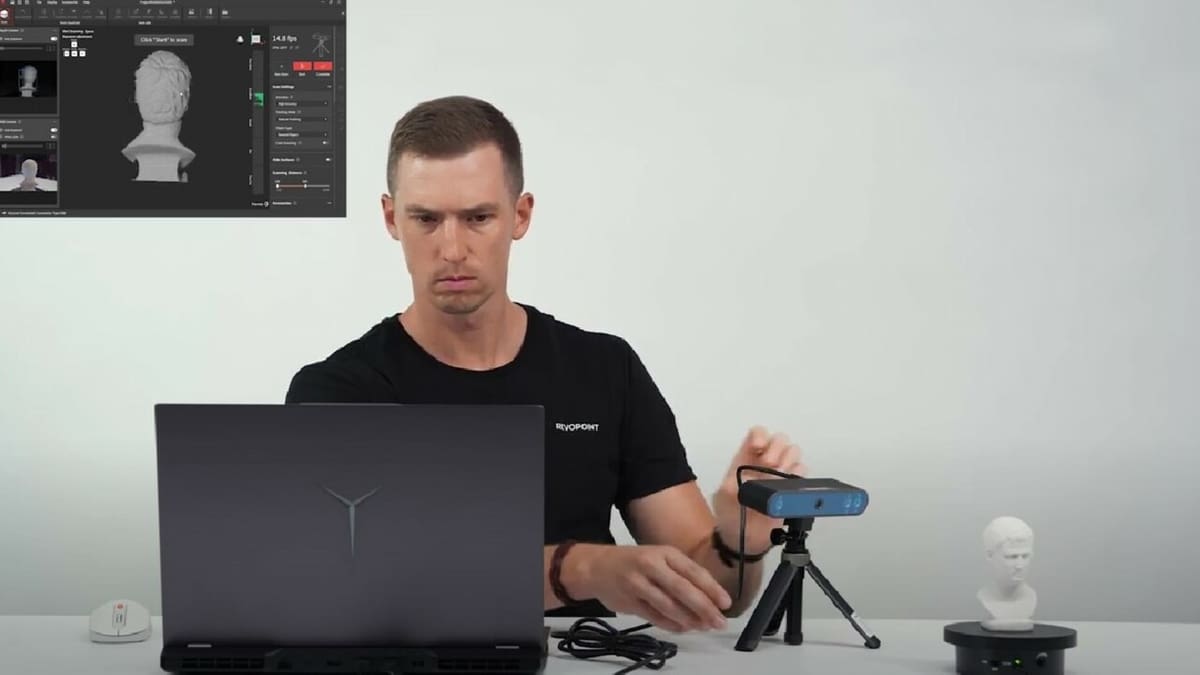
Revopoint’s Pop 3 is the best bang for buck 3D scanner for people who are looking to get started with 3D scanning and as well as hobbyists looking to acquire one for their DIY projects. The scanner really shines when it comes to the range of features and flexibility it offers at this price point.
The scanning head is highly flexible and portable. The standard package includes a tripod, mini turntable, phone holder, calibration board and a carrying case – everything you need to set up your device and start scanning in a jiffy. The scanner is also a plug-and-play device and works via a USB-C port.
The scanner works based on the infrared structured light technology and offers rapid scanning speeds of 12 to 18 frames per second, which is great for handheld scanning. Don’t let the speed fool you, though. The scanner is precise and has a single-frame precision of up to 0.05 mm.
The scanner is very intuitive to use and has three touch sensitive buttons behind the scanning head to control the scan exposure and also to start or pause scans. Wi-Fi 6 connectivity is provided as standard, ensuring fast wireless data scanning and low latency when used in the wireless scanning mode. The USB-C connectivity allows the scanner to be connected with mobile devices. The Revo Scan app, however, needs to be installed on your mobile device.
The Revo Scan 5 software enables you to scan objects and later modify them. You can adjust the exposure and RGB color settings during the scan. Point cloud data can be fused to generate a smoothed-out mesh. You also can perform primitive operations such as removal of foreign objects or removing parts of the model by defining a plane. To take full control of your scanned model, you’ll need Revo Studio, which enables post-processing of 3D models in PLY, OBJ, and STL formats.
- Camera resolution: 1.0 megapixel
- Single shot accuracy: 0.05 mm
- Scanning volume: 2,500 x 2,500 x 2,500 mm
- Technology: Dual-camera infrared structured light
- Price: ~$660 (standard), ~$770 (advanced)
Intermediate – EinScan-SP V2

If you’re familiar with 3D scanners, there is a good chance that you’ve come across the name “Shining 3D”. They’re one of the more established companies in the field of 3D scanning, and they’ve been known to offer precise scanning equipment at an affordable price point.
The EinScan-SP V2 is the latest premium desktop 3D scanning solution offered by Shining 3D. The scanner works with white structured light technology and offers a single shot scanning accuracy of about 0.05 mm. There are two modes of operation possible: You can use the scanner in Auto mode with the turntable or manually without the turntable.
In full auto mode, the scanning head is fixed to the arm extending from the turntable where the object to be scanned is placed. Auto mode can produce complete 360-degree scans in less than 45 seconds. Keep in mind, however, that the turntable has a maximum weight capacity of 5 kg.
In manual mode, the scanner is mounted on a tripod, and the turntable is not used. Doing so increases the maximum scan volume, and you’re freed from the turntable’s weight restrictions.
Regardless of which mode you choose, the resulting scans are very high quality and with all the fine details intact. The companion ExScan S software allows you to fine-tune scan settings, including the brightness of the scan, the turntable rotation settings, HDR Mode and so on. Watertight models can be generated by the software from the point cloud data, which can also be directly setup for 3D printing.
The EinScan-SP V2 is, however, not without shortcomings. Being a white light scanner, the scanner struggles a bit in poorly lit environments and glossy surfaces can also be a bit problematic. Most often the objects need to be sprayed with white paint in order to be able to scan them, which might not always be possible. The user experience with the ExScan S software also needs some work. But if you get the lighting right and properly calibrate the scanner, you can expect great details from your scans!
- Camera resolution: 1.3 megapixels
- Single shot accuracy: ≤0.05 mm
- Scanning volume: 200 × 200 × 200 mm (Auto mode), 1,200 × 1,200 × 1,200 mm (Manual mode)
- Technology: White structured light
- Price: ~$2,400
Professional – Peel 3
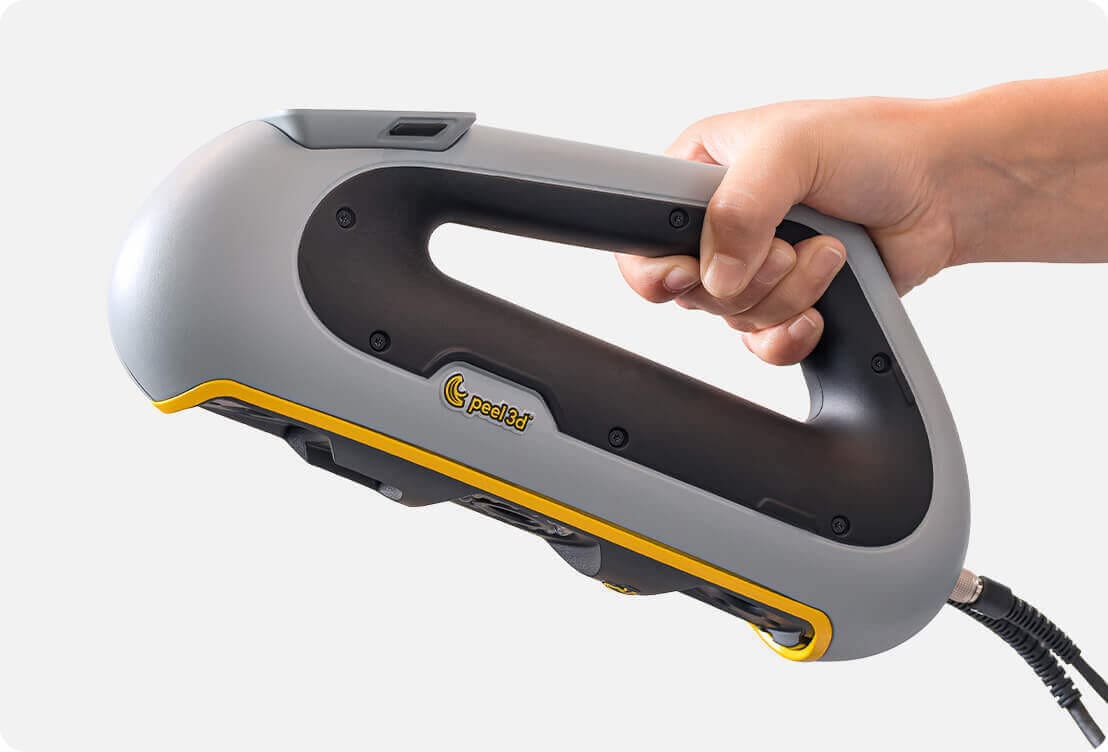
Peel 3D’s Peel 3 is a 3D scanner appropriate for professionals in a variety of fields, including product or digital media design, engineering, and preservation. Its versatility has to do with its ergonomic design and features. The scanner is more geared towards handheld scans, and this is reinforced with the great haptic feedback during scanning. A full-touch LCD display at the back of the scanning head controls your scans.
The Peel 3 offers a phenomenal accuracy of 0.1 mm, implying that all of the fine details in your model will be captured as is. With a measurement rate of 1,250,000 measurements per second, the scanner is also extremely quick in capturing data. You can also scan objects as wide as three meters.
The real reason why this scanner got a mention in our article is because of the software scanning experience. The standard Peel 3 comes bundled with Peel.OS software. The software provides options to customize your scan settings before scanning your object, including the size of your object, the quality of your scan, output mesh format, and color information to be captured.
Once you’re done with scanning, there are various tools within Peel.OS to clean up your scans. The software offers tools to combine and align multiple scans, ability to modify features of your scan, removal of unwanted artifacts, smoothing out meshes, and the ability to reapply color and texture information once .
If you’d also like to reverse engineer your models, the Peel 3.CAD package might come in handy. Meshes scanned with the Peel.OS software can be imported into the Peel.CAD environment, where one has the ability to extract geometrical entities and surface data into native CAD file formats. This could be useful if you want to make a digital copy of the object and modify its features. The package includes the Peel 3 scanner as well as two licenses for Peel.CAD software.
- Camera resolution: Not specified
- Single shot accuracy: 0.1 mm
- Scanning area: 340 x 475 mm
- Technology: Dual-camera infrared structured light
- Price: ~$8,500
License: The text of "The Best 3D Scanners for 3D Printing" by All3DP is licensed under a Creative Commons Attribution 4.0 International License.
CERTAIN CONTENT THAT APPEARS ON THIS SITE COMES FROM AMAZON. THIS CONTENT IS PROVIDED ‘AS IS’ AND IS SUBJECT TO CHANGE OR REMOVAL AT ANY TIME.

